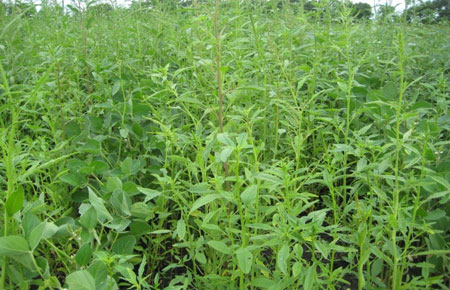Why Residual Herbicides are Important Tools in Battling Hard-to-Control Weeds
Several summer annual weed species in Nebraska emerge at the same time as corn and soybean. Common waterhemp, Palmer amaranth, velvetleaf, and foxtail species can be particularly troublesome in some parts of Nebraska. Giant ragweed, kochia, and marestail emerge early and preplant herbicide applications can help manage these species. Many populations of these species in Nebraska are glyphosate-resistant. Alternate weed management programs, other than glyphosate alone, are needed to manage these populations. (See this CW article.

Figure 1a. Nontreated control (Photos by Amit Jhala)

1b. Valor XLT 4 oz/acre pre-emergence at 30 days after application

1c. Sonic 5 oz/acre pre-emergence at 30 days after application
Developing a Successful Pre-emergence Program
The pre-emergence (residual) herbicides mitigate yield loss due to weed competition, provide a longer time for the crop to establish, and reduce the selection pressure for resistance to post-emergence herbicides. In addition, including pre-emergence herbicides can minimize the post-emergence herbicide applications and protect against early-season weed competition when weather or busy schedules prohibit a timely post-emergence application.
It is important to consider herbicides with multiple modes of action. Several new herbicides registered in corn and soybean are a premix of herbicides with different modes of action. (See these Crop Watch articles for new corn and soybean herbicides). Application of a pre-emergence herbicide is particularly important in fields where herbicide-resistant weeds are present or suspected. An effective pre-emergence application can go a long way to controlling a problem weed population, especially when post-emergence herbicide options are limited or limited in effectiveness.
UNL research as shown that adding a residual herbicide helps keep fields free of yield-robbing weeds longer and improves yields and resistance management practices. For example, a two-year study by UNL weed scientists near Fremont demonstrated season-long control of glyphosate-resistant common waterhemp when a pre-emergence herbicide with multiple modes of action was applied (Figure 1).
Yet with several products on the market today, it is important for farmers to know what to look for in a residual herbicide. Selection of residual herbicides should be based on one or more of the following:
- Weed spectrum
- Length of residual activity
- Modes of action
- Application timing flexibility
- Ability to control herbicide-resistant weeds
- Crop rotational flexibility
Among the herbicides with multiple modes of action registered for pre-emergence weed control are:
- Corn: Anthem ATZ, Bicep II Magnum, Breakfree NXT ATZ, Cinch ATZ, Corvus, Degree Xtra, Instigate, Fierce, Lumax/Lexar EZ, Surestart II, Tripleflex II, Verdict, and Zemax
- Soybean: Afforia, Anthem, Authority Assist/Elite/First/Maxx/MTZ/XL, Boundry, Envive, Fierce, Fierce XLT, Optill Pro, Pummel, Prefix, Torment, Trivence, and Valor XLT.
Always read and follow herbicide label directions.
For More Information
For a more comprehensive list of registered pre-emergence corn and soybean herbicides see the 2015 Guide for Weed Management in Nebraska (EC130) published by University of Nebraska-Lincoln.
Amit Jhala, Extension Weed Management Specialist
Greg Kruger, Extension Weed Science and Application Technology Specialist
Online Master of Science in Agronomy
With a focus on industry applications and research, the online program is designed with maximum flexibility for today's working professionals.
